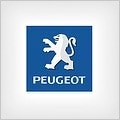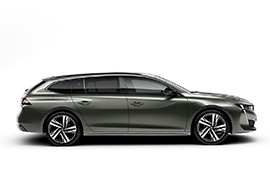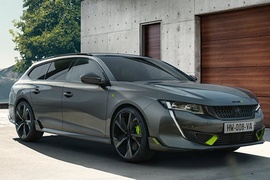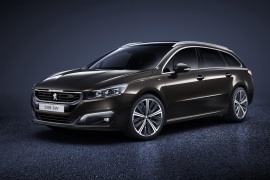
PEUGEOT 508 SW
Generations Timeline, Specs and Pictures

Peugeot didn’t want to quit on their share of large station-wagons on the European market and it announced the second generation of the Peugeot 508 SW in May 2008.
After the initial announcement, the car was unveiled at the Geneva Motor Show, in June 2008. While its predecessor had more like a calm look, the 2018 model offered an angry-looking face with a sporty design. The company’s French management thought that, since there was a bigger concern about environmental issues, the buyers will return to station-wagons from the cross-over and SUV car-categories. So, Peugeot wanted to be prepared and launched its five-door version of the 508.
The 508 SW featured optional LED headlights and two “fangs” that crossed from the headlights through the bumper toward the lower grille. The main grille though was smaller but with a 3D design instead of a mesh. Viewed from the side, the car looked more like a shooting brake than a regular station-wagon, with raked rear D-pillars and a roof-spoiler.
Inside, the i-Cockpit was the name of the infotainment and instrument cluster unit. It was based on two large displays, one in front of the driver and the other on the center console. The luxurious interior was more part of the premium-car market than in the mass-market category.
Despite the long vehicle and sporty look, the 508 SW featured rather small turbocharged engines instead of big displacement units. The standard transmission for some engines was a 6-speed manual while an 8-speed automatic was offered as an option.

Peugeot Sport Engineering upgraded both the station-wagon and the sedan as well.
The special department was responsible for creating successful race-cars, and in 2020 they applied their knowledge to the production vehicles.
Peugeot is one of the oldest brands in the motoring industry. Even if it started with coffee mills and bicycles, the French brand made its way into the world, and its name was tightened with victories on various races such as the LeMans, Paris-Dakar, Pike’s Peak or the World Rally Championship.
The 508 PSE featured a new front fascia, with an LED strip for the daytime running lights that crossed the headlight onto the front bumper. The Kryptonite color (a special gray) was offered exclusively on the PSE range. They used the same color for the three-claws badges on the back and the car’s side. Even if the car was named station-wagon, since it was based on a car that was more of a four-door coupe, its overall shape was closer to a Shooting-brake.
Inside, the French specialist put the three-claw badge on the bottom of the steering wheel, but in green-lime accents. Another line with the same color crossed the dashboard. The Peugeot i-Cockpit graphic animations and the central 10-inch HD capacitive touchscreen have adopted the division’s signature for an even more upscale feel.
The powertrain was a significant development. It featured a plug-in hybrid drivetrain that offered 360 hp. The battery pack could recharge in less than two hours from a 7kW wall-box socket or seven hours from a standard home outlet. It featured a 42 km (26 miles) range on EV mode. On top of that, the 508 PSE was all-wheel-drive. The gasoline engine powered the front wheels while the electric motor sent its power to the rear axle.

As with the sedan, the 2014 midlife cycle brought Peugeot’s 508 SW small but powerful changes, making it look almost like a new model.
Most design changes can be seen at the front end, where the sedan got new LED headlights, a redesigned split grille, bumper and chrome trimmings. The rear received some nice LED taillamps as well as a slightly redesigned bumper.
Inside, you’ll find a 7-inch touchscreen display, a reversing camera feature along with a blind spot monitoring system and phone connectivity. Most buttons have disappeared to leave for a cleaner 308-looking dashboard.

While the Peugeot 508 sedan might be a replacement for both 407 and 607, the 508 SW was clearly the successor of the 407 SW.
The French carmaker had a long history with station wagons behind it, and it didn’t want to give up on them yet in 2010 when it introduced the 508 SW. But the Sochaux Lion didn’t think about that kind of bodywork as a regular family vehicle with a bigger trunk. It considered it as a vehicle fit for leisure. Moreover, it was available with features that were not included on the sedan’s options list.
From the outside, the 508 SW kept most of its front parts from its sedan sibling up to the B-pillar. Behind that, it changed everything. First of all, the design team extended the roof to a slight slope toward the car’s back. The D-pillars were raked forward and fitted a roof-spoiler on top of the tailgate. Unlike the sedan, the SW was available with a panoramic glass roof, which brought more light inside the car.
The interior featured a German-inspired dashboard, with the infotainment screen placed at the cross-section between the center stack and the horizontal panel. Inside the instrument cluster Peugeot installed four large dials for the speedometer and tachometer, and the gauges for the fuel level and coolant temperature between them, on top. Something “Audish,” but it worked well. Unlike the sedan, the SW version featured a split-folding rear bench that expanded the trunk size from 530 liters (18.7 cu-ft) up to 1780 liters (62.9 cu-ft) for the 2WD versions.
Peugeot used the EMP2 platform for the 508 SW, which was built to get gasoline and diesel engines. A hybrid version with an all-wheel-drive system was available as well.























































